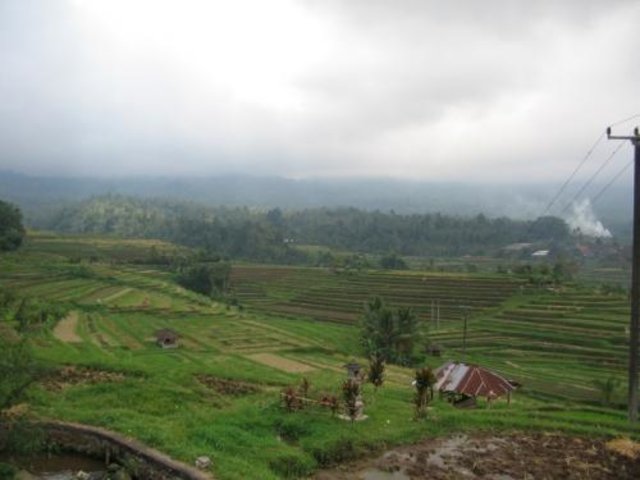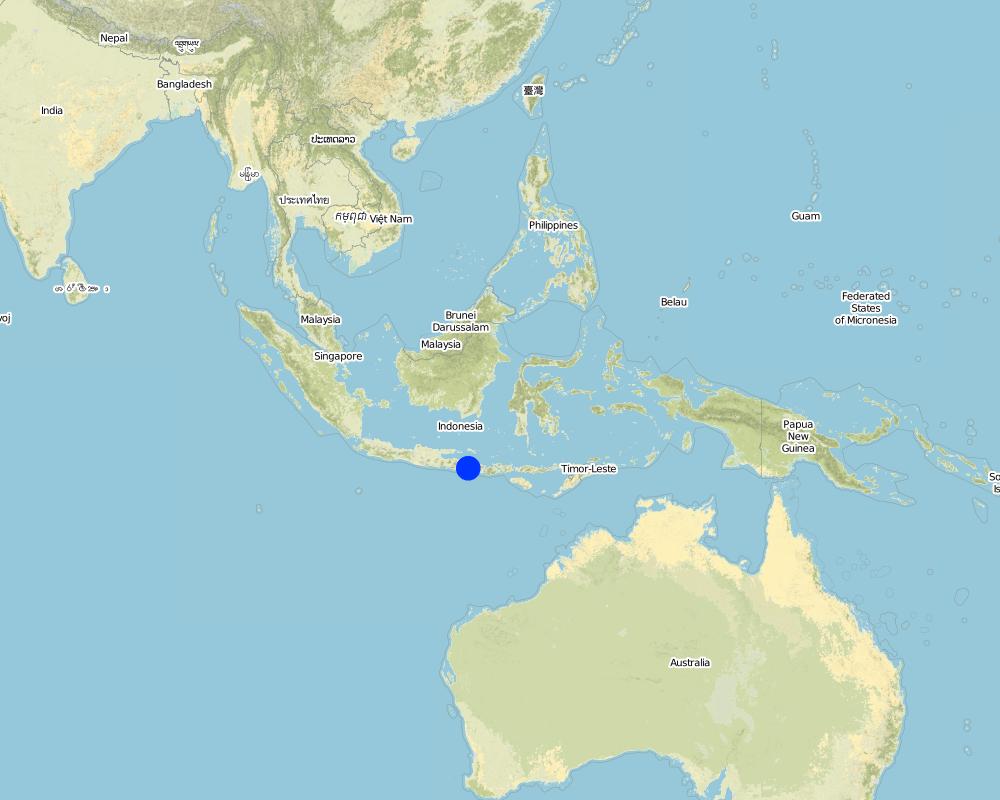Paddy Field Terrace [Indonesia]
- Creation:
- Update:
- Compiler: Philippe Zahner
- Editor: –
- Reviewer: Fabian Ottiger
approaches_2375 - Indonesia
View sections
Expand all Collapse all1. General information
1.2 Contact details of resource persons and institutions involved in the assessment and documentation of the Approach
1.3 Conditions regarding the use of data documented through WOCAT
The compiler and key resource person(s) accept the conditions regarding the use of data documented through WOCAT:
Yes
1.4 Reference(s) to Questionnaire(s) on SLM Technologies

Paddy Field Terrace [Indonesia]
Bench Terrace for Paddy Field
- Compiler: Lemma Ababu
2. Description of the SLM Approach
2.1 Short description of the Approach
Subak : Organization established by farmers to maintain irrigation systems, paddy field terrace, and irrigation water distribution.
2.2 Detailed description of the Approach
Detailed description of the Approach:
Aims / objectives: The main purpose is to maintain irrigation channel, distribute irrigation water efficently and justice, to keep paddy field terrace in good condition ecologycally.
2.5 Country/ region/ locations where the Approach has been applied
Country:
Indonesia
Region/ State/ Province:
Bali
Map
×2.7 Type of Approach
- traditional/ indigenous
2.8 Main aims/ objectives of the Approach
The Approach focused mainly on other activities than SLM (water distribution, irrigation channel maintenance)
Good distribution of irrigation water, good condition of irrigation channel and paddy field terrace, high production & income.
The SLM Approach addressed the following problems: Distribution of irrigation water in justice, irrigation channel in good condition, environment of paddy field terrace in good condition.
2.9 Conditions enabling or hindering implementation of the Technology/ Technologies applied under the Approach
availability/ access to financial resources and services
- hindering
high production cost
Treatment through the SLM Approach: subsidy
legal framework (land tenure, land and water use rights)
- enabling
The existing land ownership, land use rights / water rights moderately helped the approach implementation
3. Participation and roles of stakeholders involved
3.1 Stakeholders involved in the Approach and their roles
- local land users/ local communities
Subak organization
Most meetings were attended by men. All subak members participae in the desicion making process.
- NGO
PSDA
- international organization
3.2 Involvement of local land users/ local communities in the different phases of the Approach
| Involvement of local land users/ local communities | Specify who was involved and describe activities | |
|---|---|---|
| initiation/ motivation | none | |
| planning | none | |
| implementation | none | |
| monitoring/ evaluation | passive | |
| Research | none | on-farm |
3.4 Decision-making on the selection of SLM Technology/ Technologies
Specify who decided on the selection of the Technology/ Technologies to be implemented:
- mainly land users, supported by SLM specialists
Explain:
consultative
Decisions on the method of implementing the SLM Technology were made by mainly by SLM specialists with consultation of land users. consultative
4. Technical support, capacity building, and knowledge management
4.1 Capacity building/ training
Was training provided to land users/ other stakeholders?
Yes
Form of training:
- on-the-job
- farmer-to-farmer
4.2 Advisory service
Do land users have access to an advisory service?
Yes
Specify whether advisory service is provided:
- on land users' fields
Describe/ comments:
Name of method used for advisory service: group meeting; Key elements: media of training, market information; 1) Advisory service was carried out through: government's existing extension system 2) Advisory service was carried out through: government's existing extension system; Extension staff: mainly government employees
Advisory service is quite adequate to ensure the continuation of land conservation activities; increasing the capacity of extension workers
4.3 Institution strengthening (organizational development)
Have institutions been established or strengthened through the Approach?
- yes, a little
Specify the level(s) at which institutions have been strengthened or established:
- local
Specify type of support:
- equipment
4.4 Monitoring and evaluation
Is monitoring and evaluation part of the Approach?
Yes
Comments:
bio-physical aspects were None monitored through observations
technical aspects were None monitored through observations
socio-cultural aspects were None monitored through observations
economic / production aspects were None monitored through observations
area treated aspects were None monitored through observations
There were no changes in the Approach as a result of monitoring and evaluation
5. Financing and external material support
5.1 Annual budget for the SLM component of the Approach
Comments (e.g. main sources of funding/ major donors):
Approach costs were met by the following donors: local community / land user(s) (-): 100.0%
5.2 Financial/ material support provided to land users
Did land users receive financial/ material support for implementing the Technology/ Technologies?
Yes
5.3 Subsidies for specific inputs (including labour)
- equipment
| Specify which inputs were subsidised | To which extent | Specify subsidies |
|---|---|---|
| machinery | fully financed | |
| tools | partly financed | |
- agricultural
| Specify which inputs were subsidised | To which extent | Specify subsidies |
|---|---|---|
| fertilizers | partly financed | |
| Biocides | partly financed | |
5.4 Credit
Was credit provided under the Approach for SLM activities?
No
6. Impact analysis and concluding statements
6.1 Impacts of the Approach
Did the Approach help land users to implement and maintain SLM Technologies?
- No
- Yes, little
- Yes, moderately
- Yes, greatly
improvement of croping pattern
7. References and links
7.1 Methods/ sources of information
- field visits, field surveys
- interviews with land users
Links and modules
Expand all Collapse allLinks

Paddy Field Terrace [Indonesia]
Bench Terrace for Paddy Field
- Compiler: Lemma Ababu
Modules
No modules


